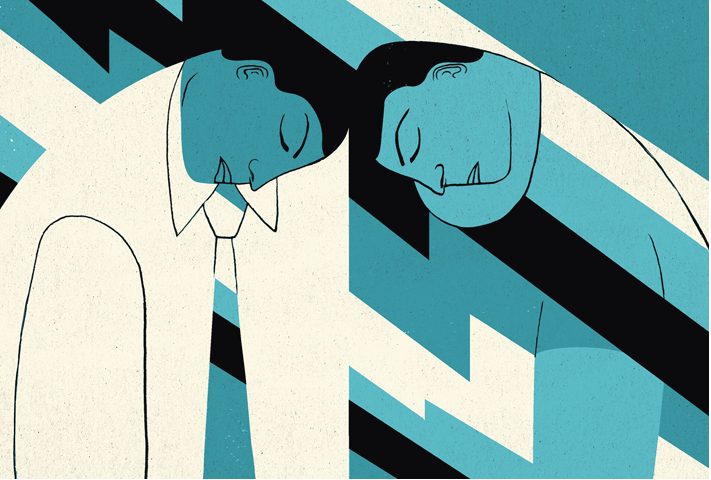Empathy
by Anna Velychko

Artwork by Hanna Barczyk
It has been postulated that one of the predictors of successful therapy, and virtually the goal of the therapy, is to establish a working alliance between the therapist and the client. Working alliance incorporates empathic response and empathic reflection. Indeed, empathy could be seen as a catalyst within the relationship of the therapist and his/her patient. Empathy allows one to understand what the other person is going through. Additionally, it will enable mirroring back to the client in a way that encourages them to open up and elaborate more on their feelings and, ultimately, decrease their resistance to the therapy. Consequently, patients thrive from this emotional connection with their therapists, social workers, as well as nurses and volunteers.
However, accordingly, to “How to Avoid Empathy Burnout” by Jamil Zaki, the helpers could get emotionally exhausted under the pressure of continuous exposure to stressful factors, which are present in any therapeutic relationship. Perceived stress could lead to high levels of job turnover, which results in discontinued therapies. At the same time, health care professionals who do choose to stay are very likely to become emotionally distant from those who are in need. Therefore, this article talks about alternative ways of how caregivers can protect themselves from the “risk being crushed by the weight of caring” (Zaki, 2016). Two critical aspects of empathy are described: 1. Emotion contagion, which entails emphatic concern, sharing other person’s feelings, and involves blurring the boundaries between self and other; 2. The concern, which preserves and even strengthens boundaries between the helper and the one is in need.
Consequently, knowing how to practice one but not the other is what could help caregivers to look out for patients, and most importantly themselves. It is crucial to mention that the distinction between contagion and concern does not come naturally, and it requires conscious training. The author of this article explains that if we feel emphatic with every person’s suffering, it would be impossible for us to trespass streets of New York without falling into an anguished heap. These words resonate with me a lot, as I consider myself a person who opens up to others very quickly. I even remember times when I was walking around New York noticing how many homeless people are out there, and I couldn’t help myself but cry. Therefore, I’m becoming more conscious and aware that if I want to continue my career as a therapist, I need to make choices on how I approach therapeutic session without emotionally exhausting myself.
Previously, I considered and thought of empathy solely within the context of therapist-patient relationships. However, after reading the article The Development of Empathy: How, When, and Why that talks about empathy as a psychological motivator for helping others in distress in general, I understood that multiple factors play a role in empathy development. For example, I have never thought that there is a genetic component that is involved in empathy. Indeed, in their longitudinal study of twins Knafo and colleagues (2008) reported that the proportion of variance in empathy associated with heritability effects increased with age, and the ratio related to shared environmental effects decreased with age. Additionally, I loved reading about the connection between mirror neurons and empathy. I learned about mirror neurons in my attention and perception psychology class last year; yet, I haven’t connected this knowledge to empathy.
Furthermore, according to the de Wall’s Perception-Action Model of empathy, viewing another’s emotional state automatically and unconsciously activates one’s associations with this particular state, causing to react to another’s experience as one would to one’s feelings. Also, I often like to contemplate on the topic of nature and nurture. In fact, in this article, they mention that there are not only inherited but also environmental factors, that contribute toward developing empathy. It is postulated that maternal warmth and secure attachment has been found to be an essential factor in promoting empathy development. Therefore, this information suggests us to pay close attention to our kids’ development as soon as they are born. Lastly, I was intrigued to learn that there are two types of empathy: emotional and cognitive (referred to as the theory of mind). Interestingly, these two types of empathy are linked to an explanation of the existence of atypical empathy, such as autism spectrum disorder and psychopathy.
“Tips on Helping Your Child Develop Empathy” by R. Parlakian and C. Lerner (2009), sheds its light on information that could and should be (in my opinion) implemented by every caring parent, to help their child to develop empathy. Authors talk about providing nurturing empathy to toddlers. This statement directly intertwines with what I’ve previously mentioned – seeing the maternal love and developing more secure attachment styles between caretakers and their babies as a successful platform for promoting empathy development in our youngsters. I find tips like using “I” message very useful. Even though these tips might seem to be obvious enough for parents to implement; yet, it is not happening too often.
We live in a high pace environment where these so-called obvious tips and suggestions pass by unnoticed. Consequently, when the child is getting older, it becomes more and more challenging for parents to establish healthy and understanding relationships. Thankfully, we live in the age of mass information flourishing and growing with research articles, as above described ones, which are available online to everybody. Also, therapists and social workers are here for us to guide and help us understand psychological traits like empathy so that we can relate to each other more and improve social relationships in general.
Annotated Bibliography
McDonald, M., Messinger D. The Development of Empathy: How, When, and Why. Free Will, Emotions, and Moral Actions. In Press.
Parlakian, R., Lerner, C.(2009, July). Tips on Helping Your Child Develop Empathy. Retrieved from www. zerotothree.org/reprints
Zaki, J. (2016, April 7). How to Avoid Empathy Burnout. Retrieved from www.nautil.us/issue/35/boundaries/how-to-avoid-empathy-burnout